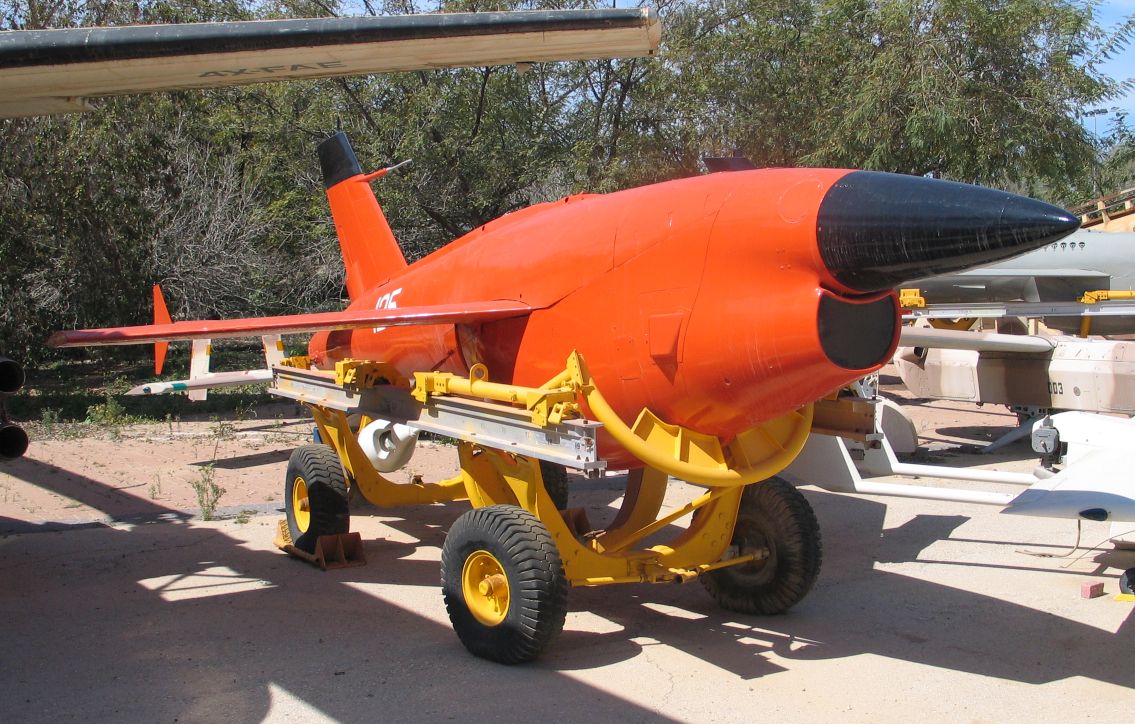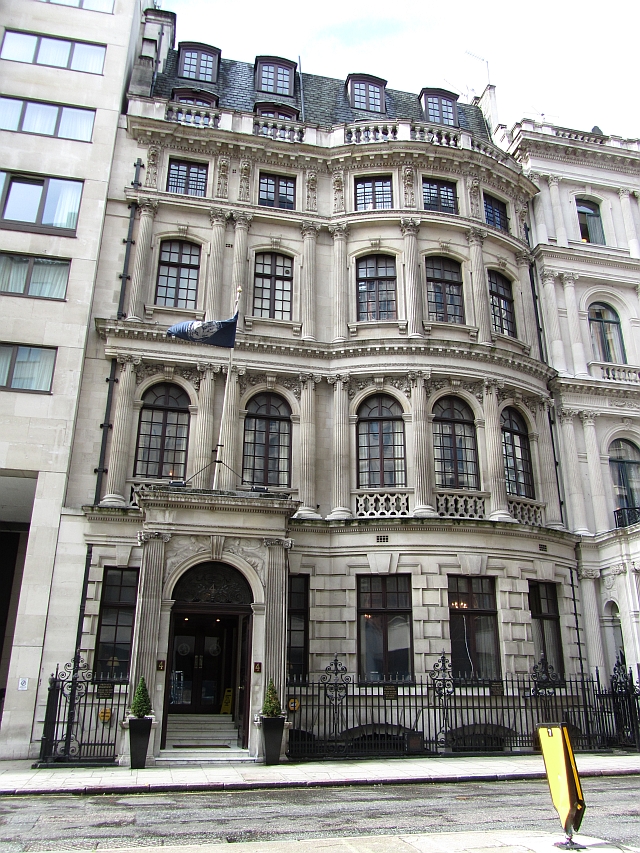|
Radioplane RP-77D
The Radioplane RP-77 was a small target drone missile, constructed largely of plastic materials, produced by the Radioplane division of the Northrop Corporation. Although the RP-77D was successfully tested by the United States Army, the decision was made not to procure the aircraft. Design and development The development of the RP-77 began in 1955.Parsch 2004. Similar in outline to Radioplane's earlier OQ-19, four prototypes of the RP-77 were constructed, two each of the RP-77, powered by a four-cylinder McCulloch piston engine, and of the RP-77A, powered by a six-cylinder Lycoming engine. Results of flight-testing were insufficient to interest the U.S. Army, however in 1957 a proposal for an improved RP-77D, powered by a Boeing 502 turboprop, resulted in a contract for the construction of 20 aircraft. The design of the RP-77D made extensive use of glass-polyester plastic materials. The drone was launched using a rocket-assisted take-off system consisting of four Loki rockets ... [...More Info...] [...Related Items...] OR: [Wikipedia] [Google] [Baidu] |
Target Drone
A target drone is an unmanned aerial vehicle, generally remote controlled, usually used in the training of anti-aircraft crews. One of the earliest drones was the British DH.82 Queen Bee, a variant of the Tiger Moth trainer aircraft operational from 1935. Its name led to the present term "drone". In their simplest form, target drones often resemble radio-controlled model aircraft. More modern drones may use countermeasures, radar, and similar systems to mimic manned aircraft. More advanced drones are made from large, older missiles which have had their warheads removed. In the United Kingdom, obsolete Royal Air Force and Royal Navy jet and propeller-powered aircraft (such as the Fairey Firefly, Gloster Meteor and de Havilland Sea Vixen used at RAE Llanbedr between the 1950s and 1990s) have also been modified into remote-controlled drones, but such modifications are costly. With a much larger budget, the U.S. military has been more likely to convert retired aircraft or olde ... [...More Info...] [...Related Items...] OR: [Wikipedia] [Google] [Baidu] |
RPTA (control)
The Valley Metro Regional Public Transportation Authority, more popularly known as Valley Metro, is the unified public brand of the regional transit system for the Phoenix metropolitan area. Within the system, it is divided between Valley Metro Bus, which runs all bus operations, and Valley Metro Rail, which is responsible for light rail operations in the Valley. In , the combined bus and rail system had a ridership of , or about per weekday as of . Valley Metro is a membership organization. Most services are separately funded and operated by individual cities and suburbs in the greater Phoenix region. These cities have agreed to participate in Valley Metro as a unifying brand name to streamline service and reduce confusion among riders. Each city appoints a representative to the RPTA board of directors, and a chairman, vice chairman, and treasurer are voted on amongst the board members for a one-year term. The two largest operators of bus service are the city of Phoenix and t ... [...More Info...] [...Related Items...] OR: [Wikipedia] [Google] [Baidu] |
High-wing Aircraft
A monoplane is a fixed-wing aircraft configuration with a single mainplane, in contrast to a biplane or other types of multiplane (aeronautics), multiplanes, which have multiple planes. A monoplane has inherently the highest efficiency and lowest drag of any wing configuration and is the simplest to build. However, during the early years of flight, these advantages were offset by its greater weight and lower manoeuvrability, making it relatively rare until the 1930s. Since then, the monoplane has been the most common form for a fixed-wing aircraft. Characteristics Support and weight The inherent efficiency of the monoplane is best achieved in the cantilever wing, which carries all structural forces internally. However, to fly at practical speeds the wing must be made thin, which requires a heavy structure to make it strong and stiff enough. External Bracing (aeronautics), bracing can be used to improve structural efficiency, reducing weight and cost. For a wing of a given size, ... [...More Info...] [...Related Items...] OR: [Wikipedia] [Google] [Baidu] |
1950s United States Special-purpose Aircraft
Year 195 ( CXCV) was a common year starting on Wednesday (link will display the full calendar) of the Julian calendar. At the time, it was known as the Year of the Consulship of Scrapula and Clemens (or, less frequently, year 948 ''Ab urbe condita''). The denomination 195 for this year has been used since the early medieval period, when the Anno Domini calendar era became the prevalent method in Europe for naming years. Events By place Roman Empire * Emperor Septimius Severus has the Roman Senate deify the previous emperor Commodus, in an attempt to gain favor with the family of Marcus Aurelius. * King Vologases V and other eastern princes support the claims of Pescennius Niger. The Roman province of Mesopotamia rises in revolt with Parthian support. Severus marches to Mesopotamia to battle the Parthians. * The Roman province of Syria is divided and the role of Antioch is diminished. The Romans annexed the Syrian cities of Edessa and Nisibis. Severus re-establish his head ... [...More Info...] [...Related Items...] OR: [Wikipedia] [Google] [Baidu] |
Radioplane Aircraft
The Radioplane Company was an American Aviation, aviation company that produced drone aircraft primarily for use as gunnery targets. During World War II, they produced over 9,400 of their Radioplane OQ-3 model, a propeller-powered monoplane, making it the most-used target aircraft in the US. In the post-World War II era they introduced their Radioplane BTT series, which was produced for years and eventually reached almost 60,000 examples. They also produced several radio control and self-guided missiles, the largest being the GAM-67 Crossbow, which didn't enter service. The company was purchased by Northrop Corporation in 1952, and moved to one of Northrop's factories in 1962. One of the last projects carried out at the original Radioplane factory in Van Nuys, California, was the construction of the Advanced Gemini#Other proposals, Gemini Paraglider. History Reginald Denny Hobby Shops Reginald Denny (actor), Reginald Denny served with the Royal Flying Corps during World War I, and ... [...More Info...] [...Related Items...] OR: [Wikipedia] [Google] [Baidu] |
Royal Aeronautical Society
The Royal Aeronautical Society, also known as the RAeS, is a British multi-disciplinary professional institution dedicated to the global aerospace community. Founded in 1866, it is the oldest aeronautical society in the world. Members, Fellows, and Companions of the society can use the post-nominal letters MRAeS, FRAeS, or CRAeS, respectively. Function The objectives of The Royal Aeronautical Society include: to support and maintain high professional standards in aerospace disciplines; to provide a unique source of specialist information and a local forum for the exchange of ideas; and to exert influence in the interests of aerospace in the public and industrial arenas, including universities. The Royal Aeronautical Society is a worldwide society with an international network of 67 branches. Many practitioners of aerospace disciplines use the Society's designatory post-nominals such aFRAeS CRAeS, MRAeS, AMRAeS, and ARAeS (incorporating the former graduate grade, GradRAeS). ... [...More Info...] [...Related Items...] OR: [Wikipedia] [Google] [Baidu] |
International Aeronautic Federation
International is an adjective (also used as a noun) meaning "between nations". International may also refer to: Music Albums * ''International'' (Kevin Michael album), 2011 * ''International'' (New Order album), 2002 * ''International'' (The Three Degrees album), 1975 *''International'', 2018 album by L'Algérino Songs * The Internationale, the left-wing anthem * "International" (Chase & Status song), 2014 * "International", by Adventures in Stereo from ''Monomania'', 2000 * "International", by Brass Construction from ''Renegades'', 1984 * "International", by Thomas Leer from ''The Scale of Ten'', 1985 * "International", by Kevin Michael from ''International'' (Kevin Michael album), 2011 * "International", by McGuinness Flint from ''McGuinness Flint'', 1970 * "International", by Orchestral Manoeuvres in the Dark from '' Dazzle Ships'', 1983 * "International (Serious)", by Estelle from '' All of Me'', 2012 Politics * Political international, any transnational organization of ... [...More Info...] [...Related Items...] OR: [Wikipedia] [Google] [Baidu] |
Ryan Firebee
The Ryan Firebee is a series of target drones developed by the Ryan Aeronautical Company beginning in 1951. It was one of the first jet-propelled drones, and remains one of the most widely used target drones ever built. Development Ryan Firebee I Q-2/KDA-1 Firebee The Firebee I was the result of a 1948 U.S. Air Force request and contract to Ryan for a jet-powered gunnery target. The first flight of the XQ-2 Firebee prototype took place in early 1951. The drone featured swept flight surfaces and a circular nose inlet. The initial models had distinctive "arrowhead" shaped endplates on the tailplane. The Firebee could be air-launched from a specially modified launch aircraft (Douglas A-26 Invader was first to be used for this), or ground-launched with a single RATO booster. Following successful evaluation the target was ordered into production for the USAF as the Q-2A, powered by a Continental J69-T-19B turbojet engine with of thrust. The Air Force then obtained small number ... [...More Info...] [...Related Items...] OR: [Wikipedia] [Google] [Baidu] |
Nord Aviation CT20
The Nord Aviation CT20 was a French turbojet-powered radio-controlled target drone introduced in 1957. Developed from the Arsenal / S.F.E.C.M.A.S. T.5.510, the CT.20 was built by Nord Aviation and powered by a Turbomeca Marboré II engine, providing a top speed of and a flying time of 55 to 60 minutes. It has been noted for its similarity to the Ryan Firebee. The unmanned drone was used in the development of air-to-air missiles following the Second World War. After the startup of the turbojet, the target drone is placed on a ramp and launched using two rockets. During its flight, the drone is controlled via radio signals from the ground. As it is made of light material, it is buoyant in water and can be recovered if it is forced to land on water. Variants ;Arsenal T.5.510 / S.F.E.C.M.A.S. T.5.510 : Original design work and development of the CT.20 carried out before SFECMAS was absorbed by SNCAN. ;CT20 :Radio controlled target ;R20 :Battlefield reconnaissance drone. 62 built for ... [...More Info...] [...Related Items...] OR: [Wikipedia] [Google] [Baidu] |
GAF Jindivik
The GAF Jindivik is a radio-controlled target drone produced by the Australian Government Aircraft Factories (GAF). The name is from an Aboriginal Australian word meaning "the hunted one". Two manually-controlled prototypes, were built as the GAF Pika (Project C) as a proof of concept to test the aerodynamics, engine and radio control systems, serialled ''A92-1/2'', 'B-1/2'. The radio-controlled Jindivik was initially designated the Project B and received serials in the A93 series. Pika is an Aboriginal Australian word meaning ''flier''. Design and development The Jindivik was developed as a result of a bilateral agreement between Australia and the UK regarding guided missile testing. While the UK provided the missiles, Australia provided test facilities, such as the Woomera Test Range. As a result of the talks, Australia gained the contract for developing a target drone to Ministry of Supply specification E.7/48. The specification called for an aircraft capable of a 15-minute s ... [...More Info...] [...Related Items...] OR: [Wikipedia] [Google] [Baidu] |
Turbo-supercharger
In an internal combustion engine, a turbocharger (often called a turbo) is a forced induction device that is powered by the flow of exhaust gases. It uses this energy to compress the intake gas, forcing more air into the engine in order to produce more power for a given displacement. The current categorisation is that a turbocharger is powered by the kinetic energy of the exhaust gasses, whereas a supercharger is mechanically powered (usually by a belt from the engine's crankshaft). However, up until the mid-20th century, a turbocharger was called a "turbosupercharger" and was considered a type of supercharger. History Prior to the invention of the turbocharger, |




.jpg)

